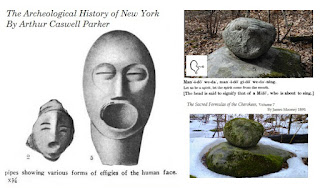Saturday, October 29, 2022
Roadside Segment of Stones (Watertown CT)
Saturday, October 22, 2022
Refining Single Stone Effigies
“While some of these
ideas are open to dispute and refinement (as should be the case with all of
science). Most are widely accepted by geologists and archaeologists today.” –
Dr. Curtis Hoffman (Pandemic Power Point Presentation: Ceremonial Stone Landscapes).
Curtiss writes: “Effigies: These are
collections of stones – always more than two – which appear to form the shape
of animals or – more rarely – humans. As noted above, they often include “serpent”
walls as well as turtle effigies…all effigies are additive, in that they are
all collections of stones assembled so as to form a shape.”
In my experience, I
sometimes find that the effigy may be a single stone sometimes, but of course
the placement of that certain stone on another stone shows a human intention to
create an effigy, have others perceive the stone as an effigy.
Perhaps two stones is the minimum, like a statue and a pedestal:
Tuesday, October 18, 2022
Who and When?
Friday, October 07, 2022
Heavy Machinery at the Nonnewaug Wigwams Again
As I write this, I hear heavy machinery somewhere close by in this Archaeologically Sensitive area, the site of the Nonnewaug Wigwams.
Hear about any Tribal Historic Preservation Officers being notified in order to monitor construction near this Indigenous Sacred Site??
Thursday, October 06, 2022
The Fathers' Monument (Part One)
Or: Searching for an “impressive structure of native boulders, 44 feet high,” according to William Cothren.
Over thirty years ago, Woodbury CT's favorite historian William Cothren got me curious about Indigenous made stone constructions when he included absolutely no information about our family home (that I was looking for) but did include a woodcut of a stacked stone monument over what he claimed was the Grave of the Sachem Nonnewaug (that I wasn't looking for).
"The Old
Burial Ground lies on a 3.8 acre shelf to the West of Main Street, sloping to
the Hollow. This location was considered ideal for burials as the area was not
good for farmland, and the original section, on the southern end, was near the
site of the first Congregational meetinghouse. Stones date back to 1678 with
many gravestones, monuments and sarcophagi from the 17th, 18th & early 19th
century. Early graves in New England were customarily marked with uncut
boulders and many have become a piece of the stone wall that lines the east
side of the land. In 1785, construction of St. Paul’s Episcopal Church was
begun on the northerly section of this parcel and a burial ground was developed
in the church’s shadow. In time the two grounds expanded to merge, with no
division line.
The thin soil on
this parcel has been kind to seedling pines and hemlocks, some of which have
reached majestic proportions. In this cemetery each small plot holds its own
story, all part of the warp and woof of the tapestry that is Woodbury.
The Fathers’
Monument stands proudly at this site. It was dedicated during the Bicentennial
Celebration of the organization of the First Church as the Second Church of
Stratford, held May 5, 1870. This impressive structure of native boulders,
44 feet high, was erected in memory of the first three Congregational ministers
in Woodbury: Zechariah Walker, Anthony Stoddard and Noah Benedict , whose
united ministry covered a period of one hundred forty three years. The
benefactors of this monument include William Tecumseh Sherman of Civil War
fame. One third of the more than $1,500 cost was donated by an anonymous
contributor.
At the base of the
monument is an old mill wheel that was brought from Stratford by Woodbury’s
earliest settlers. It was carried between two horses on their journey and was
used to grind the grain and corn for the whole settlement at the rate of one
bushel per day..."
"A flat, irregular
slab of pasture granite lies at the foot of the monument. This original grave
marker of Rev. Zachariah Walker, who passed away in 1699, is one of the oldest
burial markers in the region..."
Whether one is a Woodbury native, or a New England enthusiast, a slow walk through this ancient burial ground will evoke a strong sense of Woodbury’s heritage…”
http://www.woodburycemetery.com/history/



















































